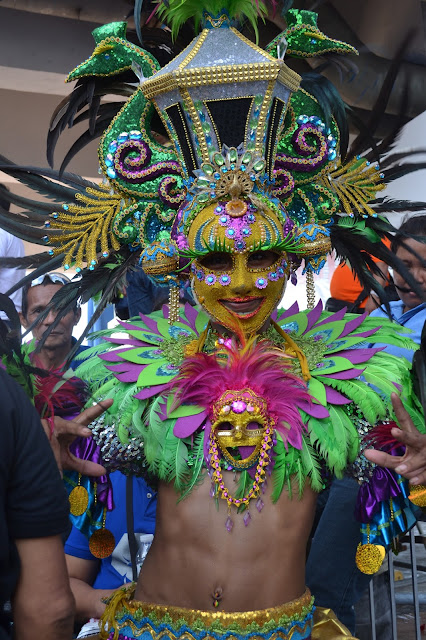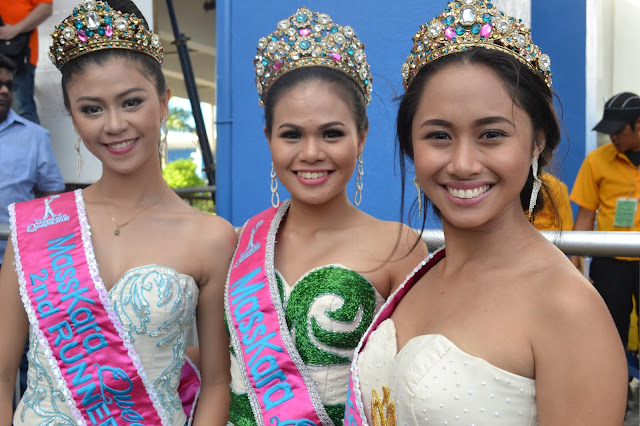By Tony Mariadass
tmariadass@gmail.com
(Vibrant Masskara festival at the
City of Smile)
When faced with adversity and hardship, few would think to organise a festival - but that is exactly what the city of Bacolod in Negros Occidental, the Philippines did in 1980.
Today it is the most colourful
festival in Philippines. Held every third weekend of October, Masskara has now
become a major national attraction and has gained popularity both at home and
aboard.
The Festival first began in 1980
during a period of crisis. The province relied on sugar cane as its primary
agricultural crop and the price of sugar was as an all-time low. In the midst
of these tragic events, Bacolodnons decided to hold a festival of smiles,
because the city at that time was also known as the City of Smiles.
The word ‘Masskara’ was coined by the
late artist Ely Santiago from the word
“mass”, meaning many or multitude of the people, and the Spanish word ‘cara’
meaning “face”. A prominent feature of the festival is the feature mask worn by
participants. These are always adorned with smiling faces. Masskara thus a
multitude of smiling faces. The smiling face which is the primary symbol of the
Festival represent the positive outlook in life that despite all the distress
and difficulties.
Truly Masskara Festival has become
pride of Bacolod City and is now a World Class Festival of the Philippines.
Held in October closest to Bacolod’s
City’ Charter Day – Oct 19, Masskara Festival dramatizes the steadfast
character of the Negrenses and symbolises what the people of Bacolod do best –
putting on a happy face and positive energy when confronted with challenges.
As the Mayor of Bacolod City Monico
Puentavella puts it: “It is time to enjoy the world’s most colourful festivals,
and the country’s happiest festival. Experience the vibrance, have fun, and
laughter, enjoy the friendship and excitements of the city’s celebration.”
While the highlight of the festival
is on the third week (Oct 11-19 this year), celebrations are actually a month
long with many pre-festival activities lined up.
Pre-festival activities include
shopping malls having mannequins dressed in Masskara costumes, seafood alleys,
Masskara nights, motorcycle races, exhibitions, boxing competitions, kite
flying competitions, fireworks displays, singing contests, gold competitions to
name a few from the long list.
A word of caution to those wanting to
make the trip next year – make your hotel arrangement at least two to three
months in advance.
Besides, the 3.1 million residents of
Bacolod City and Visayas, they have visitors from all over the world besides
locals from other islands of Philippines.
Koreans who are many in Philippines,
who besides doing business have used the country as their base to study the
English language, make up the majority of the revellers besides Japanese and
Europeans.
Street parties, endless variety of local food,
crazy costumes and smiles all around, make the festival it and unforgettable
experience.
With the
beating drums and the festival songs reverberating in the air, you’d have to
fight the urge to dance. At least until the best part - the street dance
competition, where performers from different towns dance through a battle of
showmanship and creativity. Then the street is transformed into a huge dance
floor, and everyone's a competitor!
Masks are the order of the day at the
Masskara parade, as brightly-costumed men and women dance and strut in the
streets. Their beaming faces are be-dimpled, smiling and laughing in
moldedclay or papier-mâché
The last
three days of the festival is when the mayhem begins every afternoon starting
at 1pm at the longest street in Bacolod – Lacson Street – declared the Lacson
Tourism Strip – which is closed to traffic.
Dinnertime
is barbecue time and this city means only one thing – chicken insal. This delicious grilled ginger, garlic and lemongrass
infused delicacy was conceived here and Bacolod City’s best-loved culinary
export.
At this
point, it is time to resume the revelry at Lacson Street where the Masskara
steet party heightens up after sundown. Masks again are the
order of the day at the Masskara parade, as brightly-costumed men and women
dance and strut in the streets.
The masks in the history of the festival is constantly changing from
masks influenced by native Filipinos which slowly was then influenced by
carnival of Venice and Rio. Earlier Masks had feathers, native beads, and masks
were hand painted while modern masks feature plastic beads, plastic.
It’s
a sea of vibrant colours, eclectic patterns, and huge smiles.
No
festival is complete with a beauty pageant contest which is another highlight
in the festivity - of course, the
Masskara Queen is the girl with the most beautiful smile, epitomising the
spirit of the festival itself.
The
Electra-Masskara at night is another highlight of the day as the street dancers
add colourful lights to their costume and parade.
In the afternoon, qualifying rounds for the Masskara
festival are held at the Plaza in downtown Bacolod.
On the
final day, on Monday this year, the parade begins at the old stadium - Paglaum Sports Complex and ends in the city in front on the SM Mall – a
5km distance.
The 61 Barangays (districts) of Bacolod City
represents the communities that make up the total population of this city and
symbolizes the diverse subcultures that are unique within each barangay unit.
Different strokes for different folks, is clearly seen that in each barangay circle is found in distinction from among the rest.
Different strokes for different folks, is clearly seen that in each barangay circle is found in distinction from among the rest.
In fact every group is represented is
represented in the parade on the final day - civic associations, commercial
establishments, schools, even private and government organisations. They march
out in excited crowd wearing their painted masks and elaborate costumes, all
vying for prizes in judging that will be held. Floats too make the parade.
I was in Bacolod for a week and not a
day went out excitement, festivity, colour, food galore, party and of course
the smiles everywhere.
This annual festival, which has
become one of Philippines best known tourist attraction, has been earning raves
both from local and foreign tourists.
Indeed it is a festival not to be
missed and rest assured that it will etch memories which you cherish for a
lifetime.
History of Negros
Island:
It is believed that
Negros was once part of a greater mass of land but was cut off either by what
geologist call a continental drift or by rising waters during the so –called
glacial-age. Among its earliest inhabitants were dark-skinned natives belonging
to the Negrito ethnic group with their unique culture. Thus, the Spaniards
called the land ‘Negros’ after the back natives whom they saw when they first
came to the island in 1565.
How it became the
Sugar Capital of the Philippines?
The major boom to the
province at the latter half of the 19th century was the widespread
cultivation of sugarcane introduced by the Spaniards and the opening of ports
like those of Iloilo and Cebu to foreign commerce in 1856.
Key Facts:
Capital: Bacolod City
Population: 3.1 million
Land Area: 7,936.07 sq.
km (or 792,607 hectares)
Boundaries:
North – Visayan Sea;
East – Negros Occidental; South – Sulu Sea; West – Gulmaras Strait.
Getting to Bacolod
City from Kuala Lumpur:
Airlines: (to Manila)
Malaysia Airlines and Cebu Air (3 hour 15 minutes)
Connecting from
Terminal 2 or 3 in Manila by Cebu Air or Philippines Airlines to Bacolod City
(1 hour 15 minutes).
Flying Cebu Air means
connecting flight to Bacolod from same terminal – Terminal 3.














No comments:
Post a Comment